The most recent episode of Manhattan features the arrival of a character based on one of my favorite real-life Manhattan Project participants: William L. Laurence, the “embedded” newspaperman on the project. The character on the show, “Lorentzen,” appears in a somewhat different way than the real-life Laurence does, showing up on the doorstep of Los Alamos having ferreted out something of the work that was taking place. That isn’t how Laurence came to the project, but it is only a mild extrapolation from the case of Jack Raper, a Cleveland journalist who did “discover” that there was a secret laboratory in the desert in 1943, and was responsible for one of the worst leaks of the atomic bomb effort.
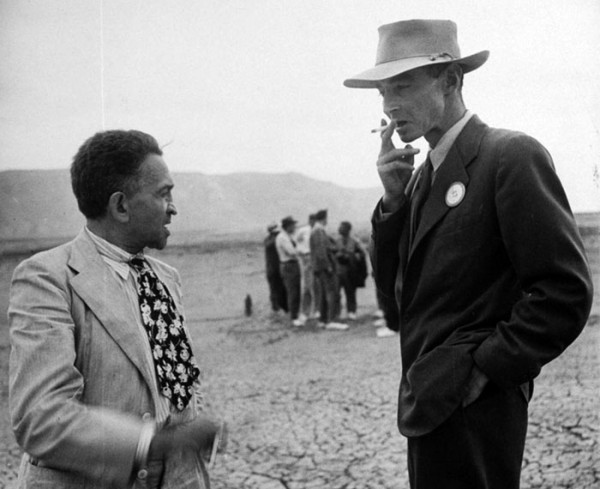
William Laurence (left) and J. Robert Oppenheimer at the Trinity Site in September 1945, as part of a “press safari” to the ruins of the first atomic test. I find the contrasts in their physiognomical contrast fascinating. Source: Google LIFE images.
William Laurence, however, was solicited. And he was the only journalist so solicited, invited in to serve as something of a cross between a journalist, public relations expert, and propagandist. (When a character on the show hisses to Lorentzen that they “don’t give Pulitzers for propaganda,” she is, as the show’s writers all know, incorrect — the real-life Laurence did receive a Pulitzer for his reporting on the Nagasaki bombing, and it was a form of propaganda, to be sure.)
William Leonard Laurence was born Leib Wolf Siew, in Russian Lithuania. In 1956 he gave an interview to the Oral History Research Office at Columbia University, and, well, I’m just going to let him tell his own “origin story,” because there’s no way I could capture his “flavor” any better than his own words do:
I was born in Lithuania, in a very small village. You know Lithuania was one of the strange never-never-lands, you might say, in a certain culture, because it was there that the Jewish intellectual, the Hebraic scholarly centers, were gradually concentrated.. …
The Lithuanian villages were out of space and time, because you know, a life there, in the ghetto, you might say — because that was the only place where the Russianized government permitted Jews to live — they lived there in the 19th century when I was born and the early part of the 20th century in a way that might have been the 15th century, the 16th century. It made no difference. They wore the same type of clothing. They lived the same kind of life, because it was the same culture, you know.1
You get the picture — the man liked to paint rather elaborate pictures with his words, no stranger to invocation ancient mysticism or cliché. Following the 1905 Russian Revolution, young Leib Siew was smuggled out of the country by his mother, in a pickle barrel, and eventually made his way to the United States. There he refashioned himself as William Laurence, and began an entirely improbable career as one of the first science journalists in the United States.2
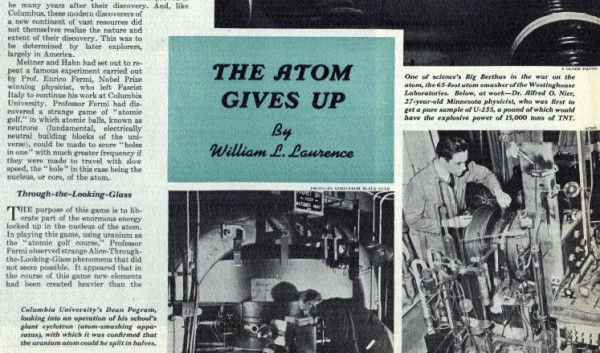
The story that brought Laurence to Groves’ attention — “The Atom Gives Up,” Saturday Evening Post, September 1940.
Laurence learned about fission in February 1939. His wife (Florence Laurence — I’m not making this up) remembered that they were walking along Sutton Place in Manhattan, towards the Queensboro Bridge, with their dachshund (named Einstein — again, not making this up), and her husband, Bill, had just come from a meeting of the American Physical Society at Columbia University, where Bohr and Fermi had spoken on fission. In her memory, Bill Laurence had “understood” the implications immediately. A fan of science fiction and a practitioner of scientific hype, he was perhaps uniquely qualified for immediately extrapolating long-term consequences. “We came home I deep gloom,” she later wrote, “The atom had come to live with us from that night on.”3
Laurence’s beat on the New York Times gave him an opportunity to write about fission fairly often. He was hooked on the idea, taking the old clichés from the earlier, radium-based nuclear age (a thimble of water containing the energy to move a cruise ship across the ocean, etc.) and adapting them to this new possibility. He wasn’t the only reporter to do so, but the Times gave him a lot of reach, as did his writing gigs for The Saturday Evening Post.
In early 1945, one of the preoccupations with the question of the bomb’s future use was what kind of information would be released afterwards. Those on the Project called this the problem of “Publicity.” Groves himself seems to have had the idea that Laurence might be a useful resource to tap. He had seen his articles, he knew his style, and he knew he was already fairly scientifically literate. That spring, Groves personally went to the offices of the New York Times to feel Laurence out for the possibility of working with the Army. Laurence said he would, but only if he got to have the whole story. Groves agreed. Laurence began almost immediately.
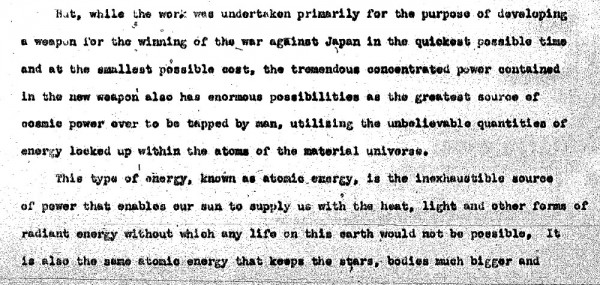
Part of Laurence’s 17-page draft Presidential statement — that was never used. View the whole document here.
Laurence’s first job was to help with the writing of draft press releases. They were already planning to drop the bomb, and they wanted to make sure they had a “publicity” blitz (as they called it) in place to advertise to the Japanese people, and the world, what it was that they had created. Laurence’s first job was to give it a shot at a statement that might be read by Truman after the first attack. His draft had that Laurence feel:
This greatest of all weapons, developed by American genius, ingenuity, courage initiative and farsightedness on scale never even remotely matched before, will, no doubt, shorten the war by months, or possibly even years. It will thus save many precious American lives and treasure. … The tremendous concentrated power contained in the new weapon also has enormous possibilities as the greatest source of cosmic power ever to be tapped by man, utilizing the unbelievable quantities of energy locked up within the atoms of the material universe. … We are now entering into the greatest age of all — the Age of Atomic Power, or Atomics.4
And so on… for seventeen pages. This kind of hyperbolic approach was not to the liking of the others on the project. James Conant, the President of Harvard, remarked that it was “much too detailed, too phony, and highly exaggerated in many places.” Fortunately, Conant wrote, “there is no danger it will be used in any such form.” The Secretary of War had called upon an old friend to write the Truman press release: the Vice President of Marketing for AT&T, and father of American corporate public relations, Arthur W. Page. Page’s work is ultimately what Truman did have issued in his name after the bombing of Hiroshima.
Which isn’t to say Laurence wasn’t otherwise useful. He wrote draft disinformation statements to be released after the Trinity atomic test, claiming it was an ammunition depot exploding. He wrote dozens of news stories that were distributed freely to the press in the days after the Hiroshima and Nagasaki bombings, explaining how the bomb worked (in basic terms), explaining how the project was organized, and telling all sorts of other side-stories that Laurence and Groves thought would satiate the demands of the American press corps — and keep them from snooping around too much on this story-of-stories.
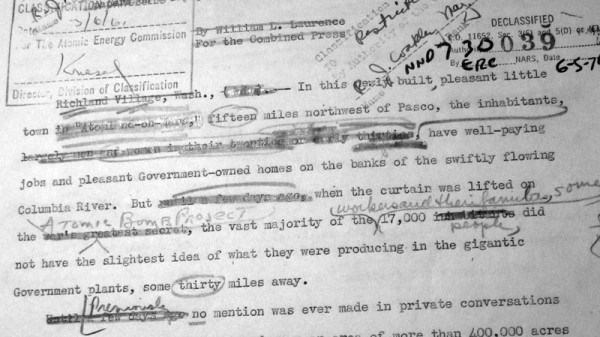
A draft of a story about Hanford that Laurence wrote. Among the many edits were getting rid of the phrase “Atomland-on-Mars,” and removing Laurence’s own name from the story. The stories were given to the press without an author listed, and each newspaper was encouraged to put their own byline on it, making the reporting on the bomb look far more varied than it was. Source: National Archives and Records Administration, Manhattan Project files.
Many of the Laurence stories, in the end, were highly edited. Laurence just couldn’t restrain himself or his writing. He couldn’t talk about Hanford Site — he had to call it “Atomland-on-Mars.” He couldn’t just write about the bomb that had been created — he had to talk about how the next stop would be conquering the solar system. A fleet of Army lawyers reviewed all of Laurence’s contributions before they were released, and the archives are full of Laurence stories that were deeply slashed and thus rendered far more sober.
Laurence was at Trinity, and was on an observation plane flying along for the Nagasaki bombing. You can sometimes see him skulking in the back of photographs from the time: short, with a somewhat disproportioned body, ill-fitting suit, and terrible tie choices.
Today Laurence is a controversial figure in some quarters. He would win a Pulitzer Prize for his reporting on Nagasaki, which came out considerably after the bombing itself took place. There are some who have called for the revocation of this prize, because he was effectively acting as a form of Army propaganda. This is true enough, though the line between “propaganda” and “embedded reporting” (or even “privileged source”) is a tricky one, then and now. Did Laurence glamorize the Manhattan Project? Sure — he thought it was the beginning of a new age of humanity, perhaps one in which war would be eliminated and we’d soon be colonizing the stars. That Buck Rogers view of things contrasts sharply with the human suffering enacted at Hiroshima and Nagasaki, and the forthcoming dangers of the Cold War, but you can see how he got seduced by the sheer sci-fi aspects of the project. He was hardly unique in that view.
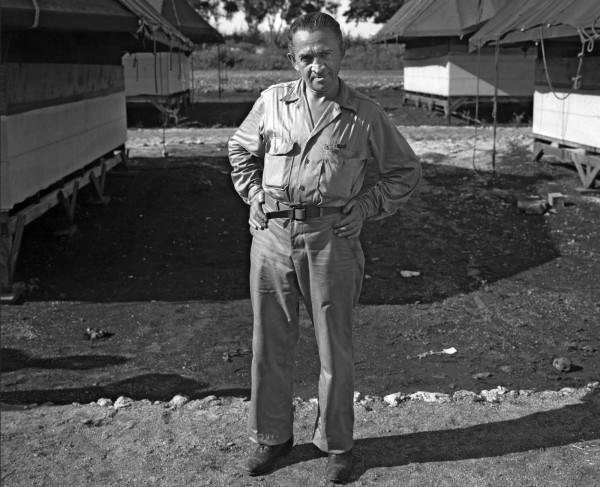
William Laurence on the island of Tinian, in the Pacific Ocean, reporting on the bombing of Nagasaki. Source: Los Alamos National Laboratory, image TR-624.
Laurence is sometimes criticized today for not reporting more on the effects of radiation from the bomb. Personally, I give Laurence a bit of a pass on this: the experts he was talking to (Oppenheimer and many others) told him radiation was not such a big deal, that anyone who would be affected by radiation would already probably have been killed by the blast and thermal effects of the bomb. They were wrong, we now know. But the US atomic experts didn’t figure that out until after they had sent their own scientists to Japan in the immediate postwar, and they didn’t trust Japanese reports during the war because they suspected they were propaganda. I don’t really think we can fault Laurence for not knowing more than the best experts available to him at the time, even though we now know those experts were wrong. I’ve never seen anything to indicate that Laurence himself thought he was telling any falsehoods.
Laurence continued to write about the bomb for much of his life. He took a strong stance against the creation of the hydrogen bomb (which he dubbed “The Hell Bomb”) and never was closely aligned with the atomic weapons sector again. It’s hard to imagine someone like Laurence — part huckster, part journalist, all wild-card — being allowed into something as secret as the nuclear weapons program today. He’s improbable in every way, a real-life character with more strangeness than would seem tolerable in pure fiction.
- William Laurence interview of March 27, 1956, in The Reminiscences of William L. Laurence, Part I (New York: Columbia University Oral History Research Office, 1964). [↩]
- I first encountered the story of Laurence in the marvelous work on the history of nuclear imagery: Spencer Weart, Nuclear Fear: A History of Images (Cambridge: Harvard University Press, 1988.) Weart’s book has been more recently revised as The Rise of Nuclear Fear. [↩]
- Prologue by Florence D. Laurence, in William L. Laurence, Men and Atoms: The Discovery, the Uses, and the Future of Atomic Energy (New York: Simon and Schuster, 1959), xi-xiii. [↩]
- William Laurence, Draft of Truman statement (unused) on use of the atomic bomb (17 May 1945), copy in Correspondence (“Top Secret”) of the Manhattan Engineer District, 1942-1946, microfilm publication M1109 (Washington, D.C.: National Archives and Records Administration, 1980), Roll 1, Target 5, Folder 4: “TRINITY Test (at Alamogordo, July 16, 1945).” [↩]



Fascinating stuff.
Have you looked at the secrecy from a psychological perspective?
There is a lot of work on the way in which secrecy produces certain types of responses in individuals, yes. There is also a bit of work on the difficulties caused by harboring secrets — it can have some very negative personal responses, and can wreck havoc on family dynamics, as several works of both fiction have explored.